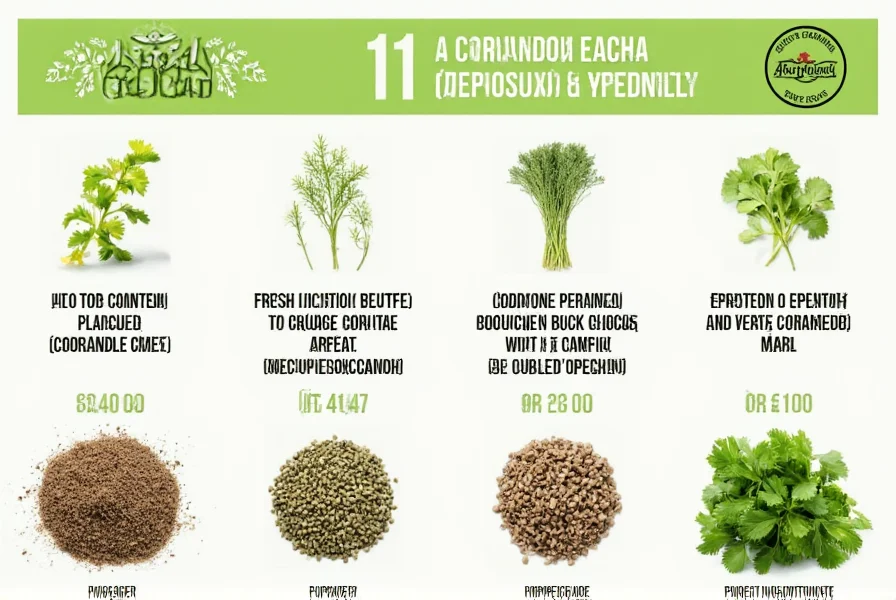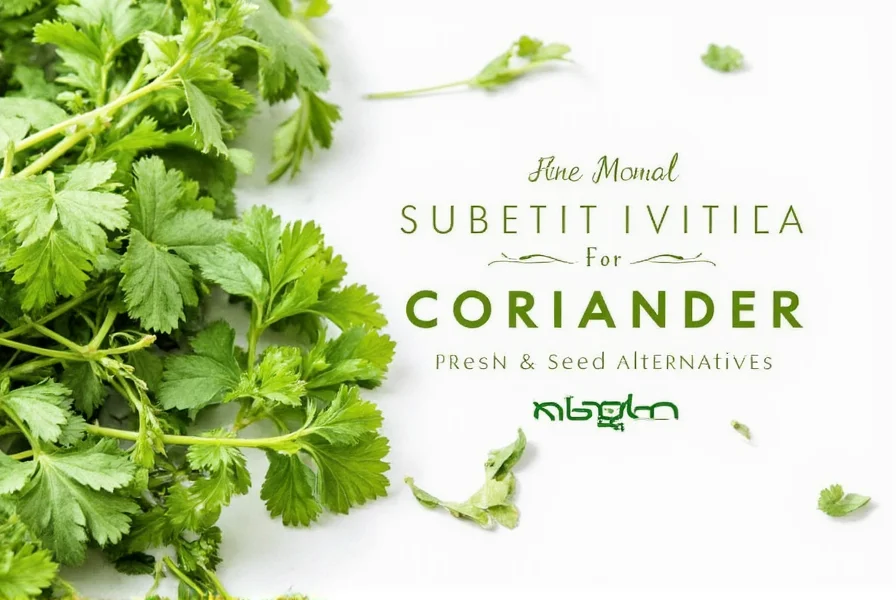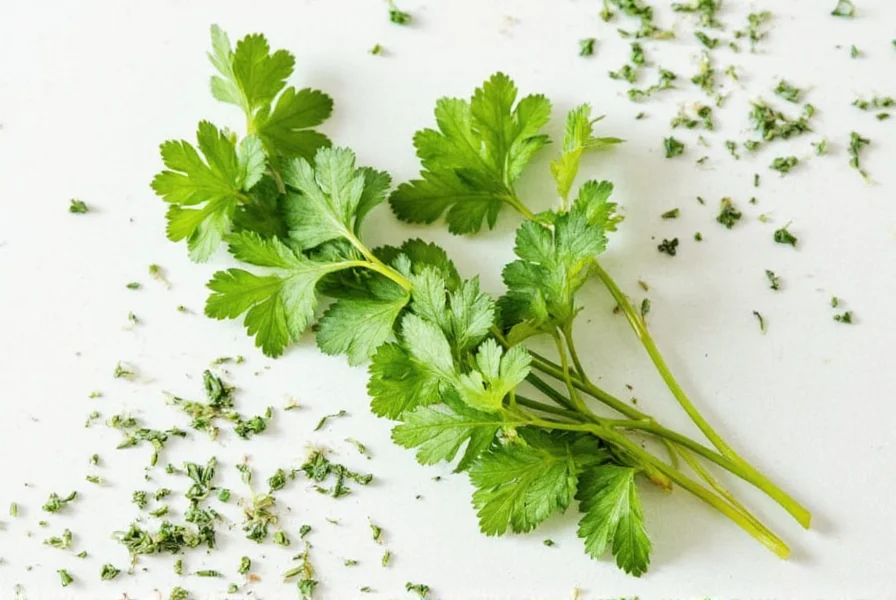When your recipe calls for coriander but you're out of this essential herb or spice, knowing the right substitution can save your dish. Understanding the difference between fresh coriander (known as cilantro in the Americas) and coriander seeds is crucial, as they have distinct flavor profiles and require different replacement strategies.
Understanding Coriander Varieties
Coriander refers to two completely different ingredients depending on context:
- Fresh coriander (cilantro): The leafy green herb with a bright, citrusy flavor commonly used in Mexican, Indian, and Southeast Asian cuisines
- Coriander seeds: The dried seeds of the same plant with a warm, citrusy, slightly sweet flavor used as a spice in curries, baked goods, and pickling
Many substitution mistakes happen because cooks don't recognize they're dealing with two different ingredients under the same botanical name (Coriandrum sativum).
Best Substitutes for Fresh Coriander (Cilantro)
When you need a fresh coriander replacement, consider these options based on your recipe's requirements:
| Substitute | Ratio | Best For | Flavor Notes |
|---|---|---|---|
| Parsley + lime juice | 1:1 parsley + 1 tsp lime per cup | Salsas, salads, garnishes | Milder herb flavor with citrus boost |
| Culantro (recao) | 1:2 (use half amount) | Caribbean, Latin American dishes | Stronger flavor, similar profile |
| Basil + mint | 3:1 ratio | Thai, Vietnamese recipes | Sweet herbal notes with freshness |
| Dill + tarragon | 1:1 blend | Fish dishes, dressings | Anise-like notes with grassiness |
Top Alternatives for Coriander Seeds
When substituting for ground or whole coriander seeds, these options work best:
- Cumin: Use ¾ the amount of coriander called for - excellent in curries and Middle Eastern dishes
- Caraway seeds: Substitute 1:1 ratio - works well in European and North African recipes
- Fennel seeds: Use ½ the amount - ideal for Mediterranean dishes and sausages
- Curry powder: Substitute 1:1 for ground coriander - best when other curry spices are already in the recipe
For the most authentic results when making coriander seed alternative in curry, toast cumin seeds with a pinch of cardamom to approximate coriander's warm citrus notes.
Regional Considerations for Coriander Substitution
The best replacement depends significantly on your regional cooking style:
- Mexican cuisine: For best cilantro substitute for salsa, use a combination of parsley and epazote (if available)
- Indian cooking: When seeking fresh coriander replacement in Indian cooking, try a mix of mint and curry leaves
- Thai dishes: For how to replace coriander in Thai dishes, use holy basil with a touch of lemon grass
Professional chefs note that in Southeast Asian recipes where fresh coriander is essential, no perfect substitute exists - consider adjusting the entire flavor profile rather than direct substitution.
When Substitution Won't Work
Certain dishes simply won't succeed with coriander substitutes:
- Chermoula (North African herb sauce)
- Traditional Indian chutneys
- Mexican pico de gallo
- Vietnamese pho garnish
In these cases, consider modifying the recipe rather than substituting. For example, in coriander leaf replacement in recipes like chermoula, you might create a parsley-based version with preserved lemon to maintain the bright, herbal quality.

Pro Tips for Successful Substitution
Follow these expert recommendations when replacing coriander:
- Add citrus elements when substituting fresh coriander to mimic its bright notes
- For dried cilantro substitute options, reconstitute dried parsley in warm water before use
- When using cumin as a coriander seed alternative in curry, reduce by 25% to prevent overpowering
- Always add substitute herbs at the end of cooking to preserve freshness
- For the most accurate coriander leaf replacement in recipes, combine two herbs to create complexity
Remember that successful substitution depends on understanding why coriander was called for in your specific recipe. Was it for color, texture, primary flavor, or background notes? This determines which substitute will work best for your culinary needs.

Frequently Asked Questions
Can I use dried cilantro as a substitute for fresh coriander?
Dried cilantro makes a poor substitute for fresh coriander as it loses most of its distinctive flavor during drying. If absolutely necessary, use 1 teaspoon dried cilantro for every ¼ cup fresh, but add extra citrus to compensate for flavor loss. For better results, consider parsley with lime juice as a more effective dried cilantro substitute option.
What's the best substitute for coriander in guacamole?
For guacamole specifically, the best substitute for fresh coriander is a combination of finely chopped parsley and a squeeze of lime juice. Add 1 tablespoon lime juice per ¼ cup of parsley to mimic coriander's bright citrus notes. Some chefs recommend adding a tiny pinch of ground cumin (⅛ teaspoon per avocado) to enhance the flavor profile without overpowering the dish.
Can I substitute coriander seeds with coriander powder?
Yes, but with important considerations. Use ¾ teaspoon ground coriander for every 1 teaspoon of whole coriander seeds. Since ground coriander loses potency faster, you may need to increase the amount slightly. For the most authentic flavor when seeking coriander seed alternative in curry, toast whole seeds briefly before grinding them yourself rather than using pre-ground spice.
Why does my coriander substitute taste soapy?
Some people have a genetic predisposition that makes cilantro (and similar substitutes) taste soapy. If your substitute tastes unpleasantly soapy, try culantro instead of parsley, as it contains different flavor compounds. Alternatively, use a combination of mint and basil, which provide freshness without triggering the soapy taste perception. This is particularly helpful when searching for fresh coriander replacement in Indian cooking where the soapy note would be undesirable.
Can I use coriander leaves instead of seeds or vice versa?
No, fresh coriander leaves (cilantro) and coriander seeds are not interchangeable. They come from the same plant but have completely different flavor profiles and uses. Fresh leaves provide bright, citrusy notes while seeds offer warm, earthy flavors. Never substitute one for the other directly - they require completely different replacement strategies as outlined in this guide for proper coriander leaf replacement in recipes versus coriander seed alternatives.











 浙公网安备
33010002000092号
浙公网安备
33010002000092号 浙B2-20120091-4
浙B2-20120091-4